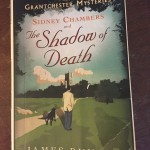Life can get exciting when we burst through the restrictions of our expected identities, especially if it’s in the hot pursuit of truth, justice and the general illumination of the human soul. You and I might do this kind of thing once in a while, but it’s risky. To watch heroes boldly striving in adventures that play out in a neat hour or two, we turn to the screen. And, in the most interesting of these, the heroes themselves can sometimes completely fall apart.
No, this won’t be about Batman, Superman, or Wonder Woman. I’m interested in someone less extraordinary, more of a regular guy, except he wears a clerical collar.
Sidney Chambers, the vicar (also called “canon” for some reason) of Grantchester, re-defines the role of Anglican priest, with panache, on Sunday evenings at 9 p.m. on PBS. Are you watching? We’re with him all the way, but it’s a rocky road all right, and everybody stumbles.

Last season, I was vaguely cognizant of the tall guy with sandy hair who teams up with his friend Inspector Keating to solve crimes, but now that it’s the featured show on “Masterpiece Theatre” I’m hooked. And I have a fine viewing companion, too. Well, actually two, if you count the black German shepherd who’s always by the couch. In fact, Sidney’s Labrador retriever — named Dickens — looks a bit similar.
We’ve started liking the new Hawaii 5-0 also; that’s great for the sweeping views of the islands and the intense chase scenes, not to mention the multi-racial make-up of the crime-fighting team and completely current technology. Grantchester, on the other hand, takes place in a quiet village near Cambridge, England during the mid-1950s, when post-war Brits strolled through fields a lot, stuck to their daily routines, and didn’t go around blurting out their innermost feelings to everyone.
The series is really all about probing the inner sanctum of the human psyche: trying to understand why people do the things they do, apprehending the worst offenders and reminding ourselves that we are all flawed human beings. Many key conversations happen in pubs or outdoors — rarely in churches — and the two main characters are essentially allies who can also flip to become antagonists. And they bring different things to the table.

The TV series is based on a series of books, each a collection of stories, by James Runcie, a novelist and filmmaker and more, who lives in Edinburgh. The author knows of which he writes when it comes to church life: his father was Robert Runcie, former Archbishop of Canterbury. Check out the author’s website, and you can learn how he created Sidney to be a figure much like he imagined his father was, back in the day. They were both brave soldiers in World War II, and that experience continues to resonate, especially when it comes to trying to tell right from wrong.
In an interview originally printed in The Telegraph (10/5/2014), also posted on the website, Runcie explained that the central feature of the drama is the collision between two ways of seeing humanity:
The paradox is simple; as a clergyman, he has to think the best of people; as a detective, he must assume the worst.
That seems a little extreme, doesn’t it? But it makes for a good drama. The contrast constantly plays out in the conversations between the two men; here’s one from the first book, called Sidney Chambers and The Shadow of Death (cover pictured above):
‘Are you sure, though, Sidney? That’s what I want you to find out. I have a feeling that you also have doubts.’
‘How did you know?’
‘I am a detective…’
‘And I am a priest. I tend to give people the benefit of the doubt.’
‘Well, I don’t. Perhaps that’s why we are such a good team.’ (p. 188)
And they ARE a good team, mostly. Sidney pays visits, which might seem just the regular pastoral sort at first, to key people who offer up crucial information about crimes and then Geordie – who tends to miss things—does the arresting. This might be a little creepy to people who would prefer that Religion and the Law keep themselves at a safe distance from one another. Our man Sidney just can’t resist being drawn into the cases, and for a small town, there sure are plenty of dire situations. Nobody much seems to question why he drops in without notice, asking probing questions, listening intently. Often, he sees something out of the corner of his eye and then dashes off, knowing exactly what the next step should be.

The two men are a good team, that is, until they come to blows — once even right in front of the altar of Sidney’s church. That was over a moral question: whether or not the death penalty, in the particular case of a young man who tried to help a young girl with an abortion that went wrong, is or is not the proper punishment. For the detective, it’s about answering the will of the people. For the clergyman, it’s about answering to God. This time, they don’t talk; they fight.
When we see our hero afterwards, all disheveled and with an almost crazed expression, we feel for him the most. He can’t keep it together, and we understand. Going deep, towards life’s very core, can be a costly expedition.
